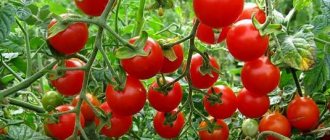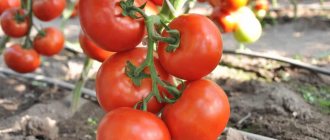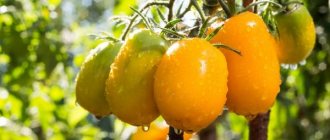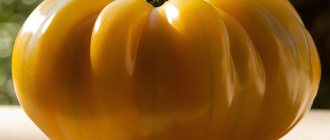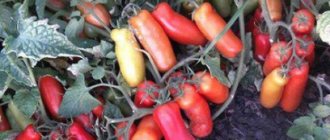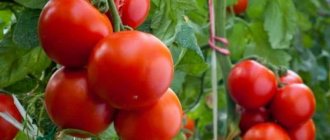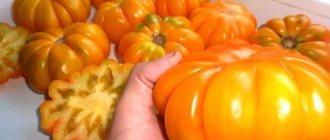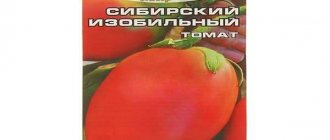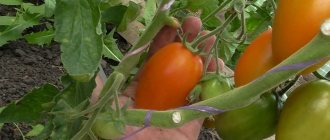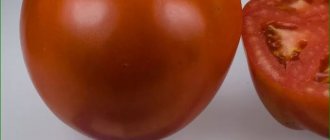Description of the variety
The originator of Ira F1 is agro, which is located in Moscow.
The application for inclusion of the hybrid in the State Register was submitted in 2009, and approved in 2010. Since then, the new cherry variety has been officially included in the state documentation on the control and protection of breeding achievements. Also, the result of the work is such popular hybrids of cherry tomatoes as Lisa, Rio, Rosa, Kira, Savva, Negro. What is the F1 hybrid on the seed package
Ira F1 is a powerful indeterminate bush with medium-sized, rich green leaves. Under favorable conditions, the bush can reach 2.5-3 m in height. It is recommended to form 1-2 stems. The tomato is successfully cultivated in the northern and southern regions, while in warm climates it shows good productivity even when grown in open ground.
What does determinate and indeterminate tomato varieties mean?
Basic properties:
Related article:
7 rules for a large tomato harvest
| Growing regions according to the State Register | North, North-West, Center, North Caucasus, Middle Volga region, Volga-Vyatka and Central Black Earth economic regions |
| Growing season | 90-95 days |
| Need for support and tying up | Yes |
| Character of fruit development | Carpal |
| Fruit shape | Oval-cuboid, with a pointed apex |
| Weight | 30-35 g |
| Coloring | Unripe fruit - light green, ripe - bright red |
| Taste | Excellent, moderately sweet with a pleasant tomato aroma |
| Productivity | 15 kg/1 m2; up to 4-5 kg per bush |
| Immunity | Strong. Resistance to verticillium wilt, fusarium wilt and root-knot nematodes is noted |
| Transportability | Excellent |
| Advantages | fruits can ripen in storage; are stored fresh for a long time after harvesting |
| Flaws | abundant pinching; with a lack of light and heat while growing a plant, the taste deteriorates |
Description and characteristics of the variety
Cherry tomato Ira is a hybrid of Russian selection. Registered in 1999. Included in the group of medium-sized standard indeterminate tomatoes. Shoots grow 1 m and higher and require pinching and pinching. In greenhouse conditions, growth and fruiting lasts up to 9 months.
Cherry Ira F1 from Semko has early ripening periods - 90-95 days from germination.
It is grown in open areas and in greenhouse conditions. The harvest is harvested with tassels. Each bunch ripens from 15 to 25 tomatoes.
Characteristics of cherry tomato fruits Ira from “Partner”:
- average weight varies in the range of 30-40 g;
- seed chambers 2-3;
- the pulp is moderately juicy, dense, sugary;
- the taste harmoniously combines sweetness and sourness;
- The skin is smooth, durable, and does not crack.
- The height of the bush reaches 85-95 cm.
Application
Ira tomatoes are dense in structure and have a hard skin. Therefore, they are not prone to cracking, which allows them to withstand transportation well without losing their marketable appearance. Professional tasters rate their taste highly, so cherry tomatoes are recommended for fresh consumption. Hybrid Ira is excellent for whole-fruit canning. Tomato juice is also made from it.
Related article:
How to speed up the ripening of tomatoes
Features of the fruit
The variety is early ripening, 90-95 days pass from sowing the seeds to the ripening of the first harvest. Fruiting is carpal, the clusters are branched, complex, each produces up to 30 small and almost identical in size tomatoes. The average weight of 1 berry does not exceed 40 g. The shape of Ira cherry berries is elongated, ovoid with a sharp protrusion at the tip of the fruit.
See also
Description of the Beefsteak tomato, characteristics of breeding the variety and yield
Read
The skin is very dense, the fruits do not crack when filling and ripening, and remain intact during canning. Cherry tomatoes Ira F1 tolerate transportation and long-term storage when ripe. The color is bright scarlet, the tassels look very decorative when ripe.
The pulp is well colored, without light areas. The consistency is dense and juicy, the tomato contains 2 seed chambers with an abundance of juice and grains. The taste qualities are rated as high: the berries are sweet, without pronounced sourness, with a pleasant aroma of tomatoes.
Such fruits have a universal purpose. They can be eaten fresh as part of a variety of salads and cuts. Miniature tomatoes are suitable for a buffet table; they can be used to decorate canapés and appetizers, served on original sandwiches or used to decorate cocktails. The bright pulp with a pleasant taste can serve as the basis for gazpacho or tomato soup; it is used to add to any hot dishes.
Mini tomatoes are also suitable for homemade preparations. Calibrated berries look impressive when mixed with gherkins and baby vegetables. Tomatoes retain their structure when pickled and salted by any means. If desired, you can make tomato juice or paste with a classic taste from them. Small-fruited tomatoes are very convenient to dry and freeze. An unusual and beautiful jam is made from unripe berries.
Growing seedlings
Tomatoes are best grown using seedlings. This method is the most reliable for obtaining a high-quality harvest. Sowing Cherry Ira F1 seeds begins in mid-March, so that after 60-65 days the finished seedlings are transplanted to the site.
Sowing is done in shallow rectangular containers or individual containers (for example, seedling cassettes). It is recommended to use ready-made substrate for vegetable crops. It contains nutritional components and does not need to be disinfected. If garden soil is used, then it must be treated with some kind of fungicide, and then “fed” with fertilizers.
Sowing is done in moist soil in furrows or holes no more than 3 cm deep. The distance between the seeds should be 3-4 cm so that the sprouts do not interfere with each other and do not get tangled. The seeds are sprinkled with soil on top and watered with warm water. Next, the container is covered with a transparent plastic lid, glass, or film and placed in a warm place until the first shoots appear. Now bright lighting is not very important for crops; ambient heat is more important. Therefore, before the seedlings peck, it is not necessary to expose the container to bright light.
Related article:
The most common red varieties of tomatoes
When the seedlings emerge, the container is moved to a well-lit windowsill not shaded by trees, preferably on the south side. For normal growth, young seedlings will need a lot of light. Therefore, on cloudy days, phyto-lamps are used for additional lighting.
In the phase of two true leaves, a pick is performed. The seedlings are transplanted into large containers (250-300 ml) for further development. The soil is well moistened beforehand so that the sprouts can be easily reached. The seedlings are dug up a little and carefully removed, trying not to damage the root.
For this procedure, you can use special tools - a spatula, a peg and a two-pronged fork.
The main root stem is pinched 2/3 of the way. This is done so that the root system produces many lateral shoots and, accordingly, the nutrition of the plant improves. Next, the sprout is placed in an individual plastic or peat container, deepening the stem down to the cotyledon leaves.
Related article:
Tricks for caring for tomatoes
Using peat pots is considered the most environmentally friendly and safe container for growing seedlings. When you need to replant the bush to a permanent place of residence, the plant is simply buried together with the pot in the ground. In this case, the earthen lump is not removed from the pot, which significantly reduces the likelihood of damage to the root system. And the pot itself will quickly dissolve in the ground, turning into natural fertilizer.
Caring for seedlings consists of the following manipulations:
- creating a thermal regime: during the day +18...+23 C, at night +15-...+16 C;
- regular watering 2-3 times a week (as needed, without moistening the soil too much);
- spraying foliage with a spray bottle once a day;
- fertilizing once every two weeks, starting from the 20th day from the moment the first shoots appear (complex mineral and organic fertilizing is used).
Related article:
Tomato Black Elephant - description and characteristics of a mid-season variety
Transplantation to a permanent place
According to the description of the originator, Ira cherry tomatoes are intended for growing in protected soil. However, many gardeners successfully practice transplanting seedlings into open beds. In any case, the plants must first be prepared before being planted for permanent residence.
Hardening of seedlings begins about a week before transplantation. By this time, the bushes should be 50-55 days old, they will have formed strong stems, two or three pairs of leaves will grow, and the first inflorescences may appear. It is impossible to overexpose seedlings, otherwise they will not develop further and will not produce a harvest. To harden, pots with sprouts are taken out to an open balcony, or loggia, or into a greenhouse, first for 30-40 minutes. Every day the duration of air baths is increased by 1-1.5. As a result, the bushes should be exposed to fresh air throughout the day. After hardening, tomato seedlings quickly get used to changes in the environment and take root better in a new place.
Related article:
Tomato "De Barao": varieties, description and characteristics
Cherries should be planted in lighted areas, preferably closer to the walls of the greenhouse, so that they receive maximum sun.
The day before transplanting, the bushes are well watered. This will make them easier to remove from plastic containers. Plant tomatoes in fertile, well-aerated soil. If the work is carried out in an open area (not in greenhouses), it would be a good idea to plant tomatoes in high beds (20 cm high). A hole is dug approximately 15 cm deep so that the roots of the plant can freely fit in it. The seedlings are taken out of the pot (if it is not made of peat or other natural material) and, together with a lump of earth, are transferred into a hole. Next, sprinkle with soil and water well. The ground around is mulched with hay, grass clippings, fallen leaves or other mulch.
Related article:
Calendar for planting tomatoes for seedlings 2021. Favorable days in February and March
If stagnation of water was often observed in the area, then it is rational to lay a drainage layer at the bottom of the planting hole.
Planting pattern – 70x40 cm. You should not plant more than 3-4 plants per 1 m2. Since the bushes of this hybrid are quite powerful, thickened beds will eventually turn into an impenetrable thicket in which it will not be possible to grow high-quality fruits.
Interesting variety: Large-fruited tomato Fleshy, sugary
Features of cultivation and storage
Seedlings are ready for transplanting at the age of 50-60 days. By this time, the bushes already have 6-8 leaves and 1 flowering brush.
4 plants are planted per 1 m2, a handful of compost and 1 tbsp are poured into holes 20-30 cm deep. wood ash.
Growing nuances:
- watering 3 times a week, water norm is 7 liters per bush;
- formation and maintenance of 2-3 shoots;
- pinching once every 10 days, cutting length within 2-3 cm;
- mulching with hay, mowed green manure, optimal layer 7-8 cm;
- garter to strong supports.
Watering
First of all, tomatoes need to be provided with a sufficient amount of water. Watering is done every day or every other day. To retain moisture for a long time, the soil must be mulched. However, there should not be an excess of water. If tomatoes receive too much water, they become watery. Also, their skin can crack, but in the Ira hybrid this flaw is rarely observed due to the dense skin.
Related article:
What not to do when growing tomatoes
Fertilizers
Fertilizing is carried out with universal organic or mineral fertilizers. Nitrogen-containing fertilizers should be applied before the ovaries appear. Nitrogen provokes the development of the deciduous part of the plant and when it is in excess, a lot of greenery is formed on the stem. As a result, all the strength of the bush goes into maintaining the foliage, and not the fruits. During the growth and ripening of tomatoes, mixtures containing potassium and phosphorus should be used, which will have a beneficial effect on the growth of tomatoes. The interval between feedings should be 3-4 weeks.
Related article:
Proper transplantation of tomato seedlings into a greenhouse
General description of the plant
The characteristics of the bush indicate an indeterminate type of stem development: tomatoes in a greenhouse grow without restrictions and can reach a height of 3 m. In open ground, vines should be pinched about 1 month before the end of the season. Flowering and fruit set may continue until the first autumn frosts, but fruits that have not reached technical ripeness are unsuitable for harvesting. Therefore, stem growth is artificially limited so that the formed ovaries have time to fully fill. You can also collect them when they are green.
The hybrid is resistant to verticellosis and fusarium, but is affected by late blight, especially in cold and rainy years. Not susceptible to blossom end rot, resistant to nematode. When grown in open ground, it practically does not reduce yield even in years unfavorable for tomatoes. Reviews from gardeners note that the taste of the berries suffers, but their quantity does not decrease.
To increase the yield of the plantation, cherry tomatoes should be formed into 1-3 stems. The liana needs tying to the trellis and pinching throughout the season. The bush forms numerous shoots, so it is not recommended to let this process get out of control. The description of the variety by those who have already dealt with it emphasizes that without pinching, the tomato turns into a sheaf of stems and practically does not bear fruit.
When placing 3-4 bushes per 1 m², a gardener can count on an average yield of 14-15 kg per unit area. You can’t plant bushes more often – this will only reduce the yield. To save space in greenhouse conditions, tall tomato bushes can be compacted with mini-tomatoes such as Coin, Pinocchio, etc. or grown with greens.
In addition to the Ira cherry tomato, there are hybrid varieties Irina and Irishka. These are early-ripening, low-growing tomatoes with large fruits. They differ from the Ira F1 variety both in the type of bush and in the appearance of the tomatoes.
Stepsoning
Cherry tomato Ira F1 is characterized by abundant formation of stepsons. Therefore, the plant must be regularly inspected and excess shoots removed. The stepson grows between the main stem and the leaf. It is necessary to break it off (not cut it) when it reaches a length of 7-8 cm, not earlier. In this case, a small stump (1.5-2 cm) is left from the stepson, since if it is broken under the base, a new shoot may appear in this place.
Tomatoes: advantages and disadvantages
The variety "Cherry Ira" F 1 is a hybrid, and it was bred in such a way that it has a lot of advantages:
- Friendly ripening of tomatoes;
- High yield;
- Excellent taste;
- Good transportability and keeping quality;
- Long fruiting period;
- Immunity to diseases;
- Tolerates drought and cold temperatures.
But there are also disadvantages:
- The bushes really need timely feeding;
- The branches are weak, and the load is heavy on them, so the bushes need supports;
- If there is not enough light for tomatoes, the taste of the fruit decreases.
Diseases and pests
The hybrid has good immunity. The plant is rarely infected with various “tomato” diseases and is practically not attacked by parasites. Especially if you follow agricultural practices: moderate watering, loosening the soil, ventilating the greenhouse, etc. However, if the bush is affected by a disease or pest activity is visible, then it is important to act immediately until the disaster progresses.
Related article:
Tricks for caring for tomatoes
Affected leaves and shoots are removed, and the tomatoes are treated with fungicides or insecticides. For minor damage, use environmentally friendly folk remedies, however, if they are not effective, they switch to chemicals.
Advantages and disadvantages, as gardeners say
Advantages:
- Productivity. The plants form long clusters; with proper care, up to 5 kg of tomatoes can be removed from each bush.
- Marketable condition. Harvest with full tassels. The skin is dense, tomatoes rarely crack. This property is preserved during canning; the tomatoes keep their shape.
- Transportation and storage do not affect the quality characteristics of tomatoes.
- Tomato exhibits resistance to a number of diseases, including verticillium, fusarium, and nematodes.
- Fleshy pulp.
The hybrid also has some disadvantages:
- Seeds have to be purchased; the “native” ones will not germinate.
- The spreading bush requires strict formation into 2 main stems, regular pinching and tying.
Reviews:
- The tomato pleasantly surprised me with its long fruiting period. With moderate watering and maintenance of 1-2 stems, they ripen until autumn. It is important to remove all the fruits before frost, otherwise part of the harvest will be lost (Natalia, Yekaterinburg).
- The size of the fruit is even, the preparations look elegant. Greenhouse plantings grow to the roof; it is necessary to pinch them in time. The taste depends on the degree of illumination of the bed. If there is not enough light, the tomatoes will be more sour (Olga, Podolsk).
Harvest and storage
Cherries are picked together with a brush or individually. They are collected as they ripen. The crop must be harvested before frost sets in, otherwise there is a risk that it will completely deteriorate. Unripe fruits will be able to reach technical ripeness outside the bush, ripening on the windowsill. If there is a need to speed up the ripening process of tomatoes on a plant, then to do this, all the leaves of the bush are torn off and the top is pinched. So that all the juices go to the fruits.
Description of the variety and miniature harvest
The originator of the Cherry Kira (or Cherrikira) F1 variety is the Moscow company Semco. Today she is producing seeds. The tomato is approved for cultivation in all regions of the country except the Far East, Siberia and the Urals. Recommended for protected soil. In practice, tomato growers harvest full-fledged harvests in open beds.
The tomato is a tall, moderately leafy bush. Sheet size is medium. The type of inflorescence is simple. The fruits are light orange (see photo), ripen in clusters of 16-20 pieces. The harvest is beautiful, neat, even. The taste combines the characteristics of cherry varieties and yellow tomatoes.
According to ripening time | By type of growth | By type of use | By growing method | Fruit weight (g) | Productivity (kg/m2) |

